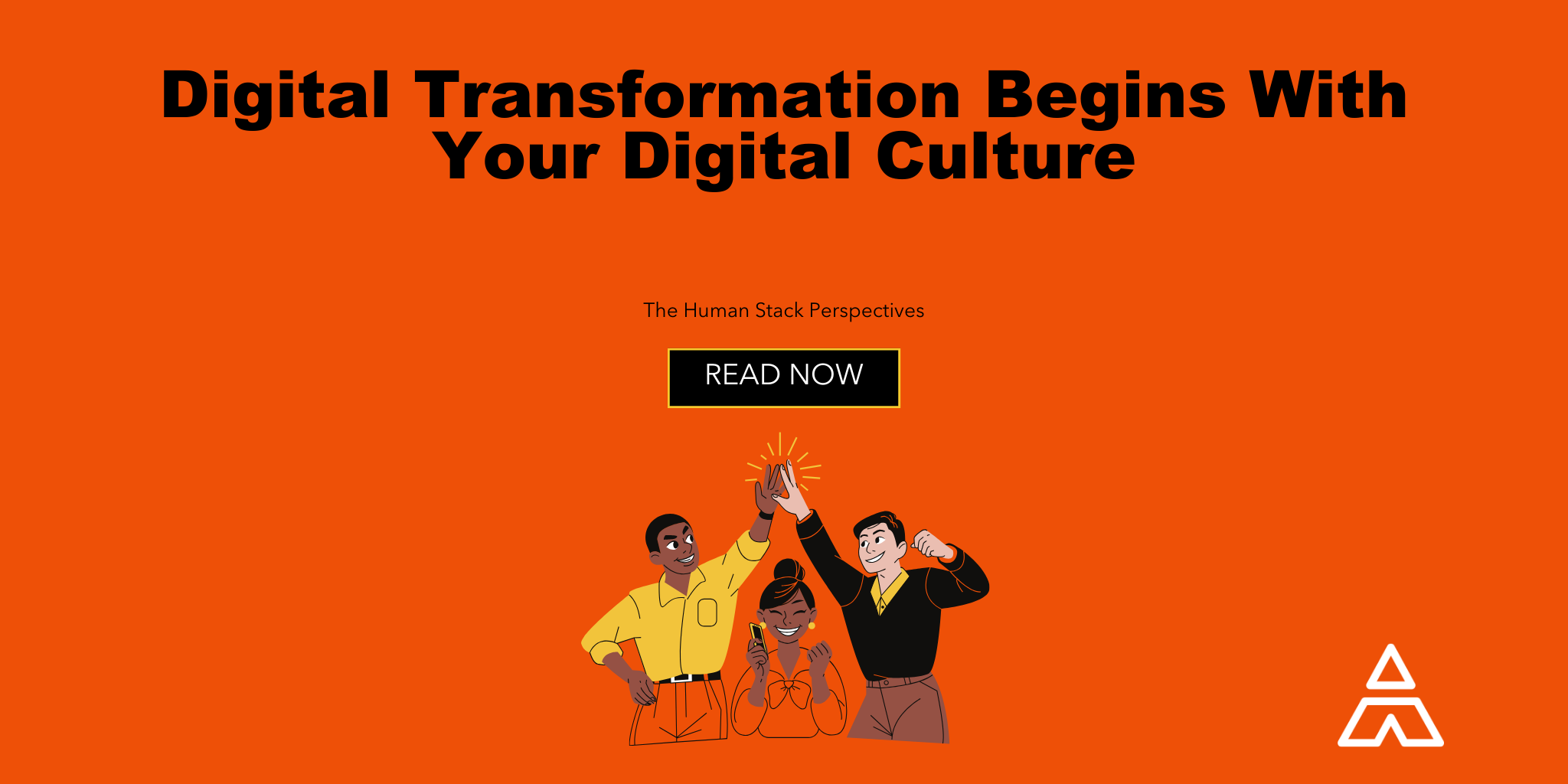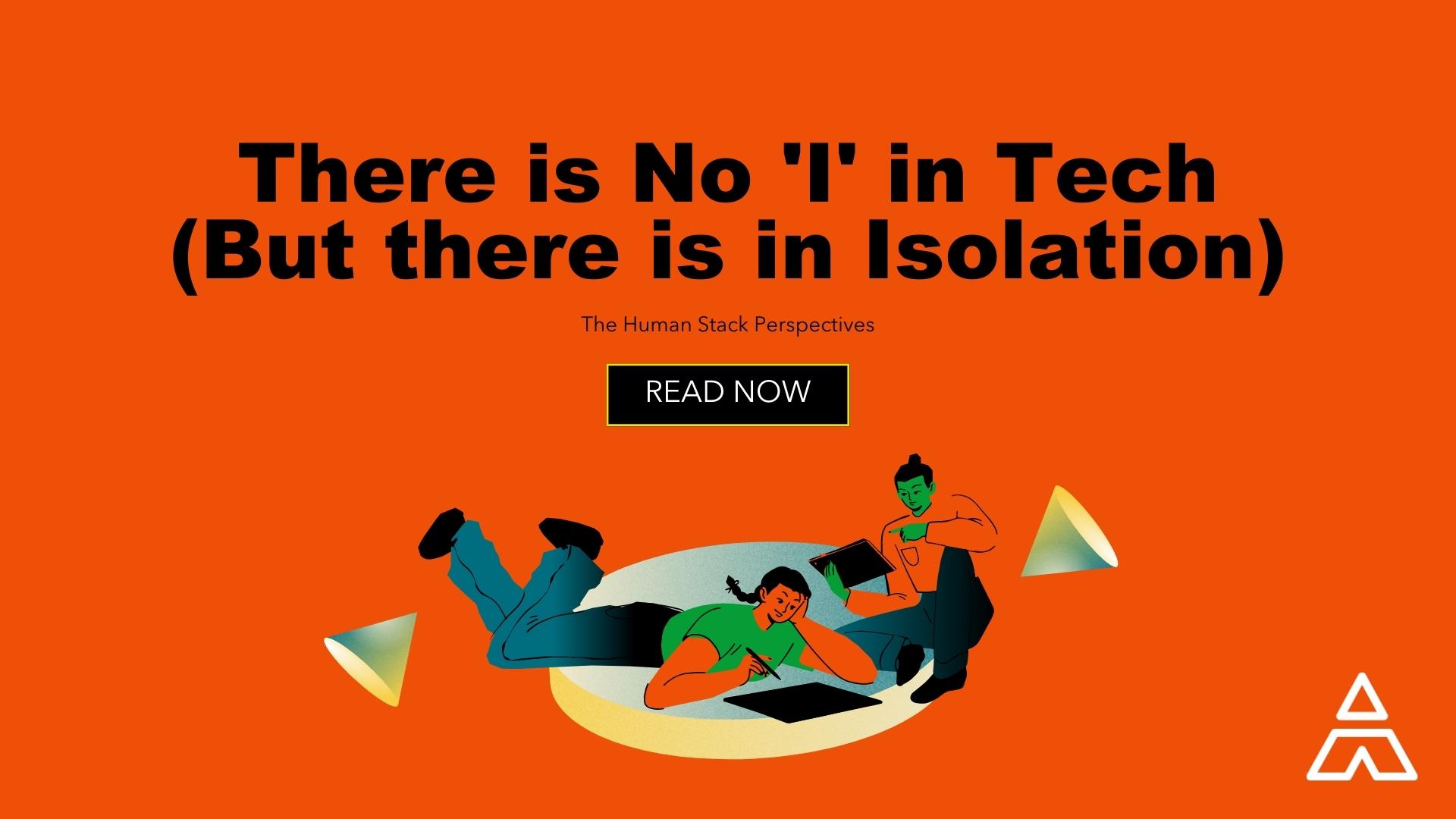9 min read
9 Reasons Digital Transformation Doesn’t Work In An Unhealthy Culture
 Tim Lockie
:
September 12, 2023
Tim Lockie
:
September 12, 2023
When organizations struggle with digital transformation, they consider what to change on the tech stack. However, these organizations should look at their culture first because Digital Transformation will only succeed in organizations with authenticity and transparency. The costs of unhealthy culture have digital costs; this article discusses signs of an unhealthy culture, nine reasons these affect digital culture and suggestions for change.
The traditional model of digital transformation focuses on the tech stack. The tech stack refers to the collection of technologies, programming languages, frameworks, tools, and software components used to build and operate a software application or system. In other words, the tech stack is the “tech” behind digital transformation.
The Human Stack focuses on, you guessed it, the human stack. The human stack refers to the collection of skills, roles, and cultural elements required to implement and adapt to technological changes within an organization effectively.
While digital technology is an important aspect of digital transformation in the digital age, the success of digital transformation relies on the people who interact with and leverage these technologies. To simplify, the human stack is the humans who use the technology.
A damaged culture is to the human stack what damaged technology is to the tech stack. In other words, enacting digital transformation without a healthy culture is like enacting digital transformation without electricity. It just doesn’t work.
What does an unhealthy work culture look like?
An unhealthy work culture is characterized by various negative attributes and practices that create a toxic and counterproductive environment. In such cultures, communication is often poor or one-sided, with limited transparency about decisions and expectations. Employees might feel disconnected from the organization's mission and goals, leading to a lack of engagement and enthusiasm for their work. Micromanagement, favoritism, and lack of accountability can be prevalent, eroding trust and causing employee frustration. In an unhealthy culture, innovation is stifled, as employees fear reprisal for suggesting new ideas, and they might be discouraged from seeking personal or professional growth.
Additionally, an unhealthy work culture tends to breed high-stress levels and burnout. Long working hours, unrealistic expectations, and a lack of work-life balance become the norm. Employee well-being often takes a back seat to short-term goals, leading to physical and mental health issues. Disrespectful behavior, including bullying or harassment, may also be overlooked or perpetuated by management. Such a culture can lead to high turnover rates as employees seek healthier environments, and it can harm the organization's reputation, hinder collaboration, and ultimately undermine its success and ability to achieve its goals.
What are unhealthy work culture red flags to watch out for?
-
Micromanagement
-
Lack of Recognition
-
Competition, not Collaboration
-
Inconsistent Leadership
-
Low Engagement
-
Favoritism
-
High Turnover
9 Reasons Why digital transformation doesn’t work in an unhealthy Nonprofit culture
- Lack Of Collaboration
- Communication Breakdowns
- Resistance To Change
- Low Morale And Engagement
- Lack Of Innovation
- High Turnover
- Poor Decision-Making
- Lack Of Trust
- Burnout
Digital transformation requires shifting how an organization operates, embracing technology to enhance processes, improving the experiences of those supported, and driving innovation. However, several factors can hinder successful digital transformation when attempted within an unhealthy digital culture.
1. Lack of Collaboration
A lack of collaboration poses a significant obstacle to successful digital transformation. Digital transformation is a multifaceted endeavor often involving integrating various technologies, processes, and departments to achieve strategic goals. When collaboration is lacking, silos emerge, where different teams or departments work in isolation. This results in fragmented efforts, duplicated work, and a lack of synergy, hindering the seamless integration of other digital technologies, tools, and processes. Without collaboration, information sharing becomes limited, preventing the organization from leveraging a holistic understanding of its needs and objectives, leading to suboptimal outcomes regarding system integration and process streamlining.
Moreover, digital transformation frequently requires cross-functional teams to work together on complex projects. A lack of collaboration can lead to misalignment of priorities, misunderstandings, and conflicting objectives among team members. This can result in project delays, scope creep, and even project failure, as the absence of effective communication and shared accountability impedes progress. Collaboration is the backbone of digital transformation, as it enables the pooling of expertise, perspectives, and resources needed to develop and implement comprehensive strategies encompassing technology adoption, change management, and business process optimization.
2. Communication Breakdowns
Communication is a crucial aspect of successful digital transformation, but what truly sets organizations apart is the predictability of their communication patterns. Our methodology has developed distinct tactical and strategic routine cycles, each with regular touchpoints. This approach ensures that tactical teams can effectively communicate with one another to accomplish their goals while also syncing up with strategic routines.
By establishing these synchronized routines, stakeholders can consistently come together at the right time and place to address the pertinent issues that arise during the transformation process. This allows tactical teams to maintain their forward momentum and continue making progress towards their objectives.
The predictability of communication patterns facilitates collaboration and coordination among teams and helps build stakeholder trust and confidence. When everyone knows when and where to expect important discussions and decisions, it eliminates uncertainty and promotes organizational stability.
3. Resistance to Change
Digital transformation involves change. Unhealthy cultures can breed resistance to change, making implementing these new business models and solutions difficult. This resistance can impede the adoption of new digital technologies and business processes critical to transformation.
Proper change management is crucial to ensuring that digital transformation means a project goes well. The proper digital transformation strategy can help ensure that business processes are changed at the proper pace for employees, and it is important to think about change saturation.
4. Low Morale and Engagement
Unhealthy cultures contribute to low employee morale and engagement. Digital transformation initiatives require team members' strong engagement to ensure the project goes well. Disengaged team members are less likely to put in the effort required for a successful digital technology project.
5. Lack of Innovation
Digital transformation requires creative problem-solving and innovation. Innovation is key to digital transformation. New ideas can lead to new and unique ways to improve business processes, create digital tools, and develop digital solutions.
In a toxic environment, employees may be reluctant to propose new ideas or take risks, which can stifle innovation. Digital transformation may take longer than necessary without this innovation and be more costly.
6. High Turnover
High turnover is detrimental to digital transformation for several reasons. Firstly, digital transformation involves implementing new technologies, processes, and strategies, often requiring specialized skills and knowledge. High turnover disrupts the stability of the workforce, leading to a loss of valuable expertise and institutional memory. When employees with critical digital skills leave, the organization might struggle to manage and operate the new digital tools and systems effectively, slowing down the transformation process and potentially leading to errors or inefficiencies.
Secondly, digital transformation is a complex and ongoing journey that requires consistent effort, collaboration, and adaptation. High turnover disrupts team dynamics, as new employees need time to onboard and understand the organization's digital goals and initiatives. Frequent turnover hampers the development of a cohesive team that can work together effectively to drive the areas of digital transformation forward. This can lead to delays, miscommunications, and a lack of shared understanding, impeding the organization's ability to navigate the challenges and changes of digital transformation successfully.
7. Poor Decision-Making
Poor decision-making stemming from an unhealthy digital culture severely hampers the progress of digital transformation efforts. A culture that lacks transparency, collaboration, and open communication often leads to decisions being made in isolation or without considering diverse perspectives. In the context of digital transformation, where decisions can have far-reaching implications for technology adoption, process changes, and resource allocation, this isolationist approach can result in misguided strategies that fail to address the organization's true needs or goals.
Furthermore, digital transformation requires agility and the ability to adapt to rapidly changing technological landscapes. An unhealthy culture that stifles innovation and discourages risk-taking can lead to conservative, status-quo decisions that hinder the organization's ability to embrace new technologies or pivot its strategy as needed. In contrast, a culture that values open dialogue, diverse viewpoints, and learning from failures fosters an environment where decisions are well-informed, forward-thinking, and adaptable. Poor decision-making caused by an unhealthy digital culture limits the organization's capacity to seize opportunities, respond to challenges, and fully leverage digital transformation's benefits.
8. Lack of Trust
A lack of trust, often cultivated by an unhealthy organizational culture, can severely hinder the progress of digital transformation initiatives. Trust is the foundation of any successful change effort, particularly in digital transformation, where employees need to feel secure about the organization's direction. An unhealthy culture characterized by a lack of transparency, inconsistent leadership, and a history of broken promises erodes employee trust. When employees don't trust their leaders, they may be resistant to change, skeptical of the organization's motives, and hesitant to fully embrace the digital transformation journey.
In an environment where trust is absent, employees may be reluctant to adopt new technologies or adapt to new processes, fearing that their efforts will go unrewarded or that changes could lead to negative consequences. Trust is essential for open communication, the sharing of innovative ideas, and the willingness to take calculated risks – all of which are critical components of successful digital transformation. When trust is lacking, employees may hesitate to share valuable insights or concerns, depriving the organization of the information it needs to make informed decisions. This hampers collaboration and stifles the collective creativity necessary for finding effective digital technologies. In essence, a lack of trust perpetuated by an unhealthy culture creates an environment of doubt and apprehension that directly obstructs the smooth execution of digital transformation initiatives.
9. Burnout
Burnout poses significant challenges to the success of digital transformation efforts, and it often arises from an unhealthy organizational culture. Digital transformation involves intense efforts to implement new technologies, adapt processes, and meet changing demands. Burnout becomes a real risk when employees are subjected to an unhealthy culture characterized by unrealistic expectations, high pressure, and lack of support. Burnout can lead to decreased productivity, engagement and a general decline in employee well-being. In digital transformation, burnout can undermine the energy and enthusiasm required to learn new technologies, adapt to new processes, and embrace the changes inherent in the digital transformation leaders' journey.
An unhealthy culture contributes to burnout by fostering long working hours, minimal work-life balance, and a lack of autonomy. Burnout becomes more likely when employees feel they have no control over their workloads or ability to influence decisions. Digital transformation is a continuous process that requires ongoing learning and adaptability. However, an unhealthy culture that doesn't prioritize employee development and well-being exacerbates burnout, making employees less willing and less capable of engaging fully in the transformation efforts. In summary, burnout from an unhealthy culture compromises employee health and well-being. It significantly impedes the organization's ability to achieve successful digital transformation due to reduced employee engagement, lowered productivity, and resistance to change.
4 Suggestions For Keeping Culture in Mind During Digital Transformation Strategy
- Model Relationships
- Sync Communication Routines
- Use Recognition Based Accountability
- Create Feedback Mechanisms
Addressing and rectifying an unhealthy work culture, especially amidst the backdrop of a digital and transformation initiative, is a substantial endeavor that demands active engagement from management. Cultivating a positive culture that aligns with the organization's digital transformation goals is a pivotal step in ensuring the success of the transformation process. A comprehensive digital transformation strategy should encompass strategic elements that specifically target the cultural issues prevalent within the organization. By integrating cultural transformation into the digital transformation strategy, organizations can create a holistic approach that enhances technological capabilities and fuels employee motivation, engagement, and adaptability, resulting in a more agile, innovative, and ultimately successful transformation journey.
1. Model Relationships
At the heart of every successful organization lies the vital relationship between its Leader and their Guide. This bond is a mutual symbiosis wherein values, behaviors, and aspirations are shared and reciprocated. When leaders and their guides operate in tandem, emphasizing open communication, transparency, and respect, it becomes a beacon for the entire organization.
This core relationship underscores the power of transparent dialogue. In such an environment, ideas and concerns aren't just shared; they are celebrated, giving way to collaborative solutions and innovations. Trust and credibility emerge from this relationship, giving the team a sense of unity and purpose.
Furthermore, the genuine respect shared between the Leader and the Guide serves as a template for others. It nurtures mutual understanding, empathy, and a culture where every member feels valued. By placing the leader-guide relationship at the forefront, we ensure that everyone in the organization feels empowered to internalize and manifest these guiding principles in their roles, fostering a truly united and motivated team.
2. Sync Communication Routines
Consistent and regular communication about project objectives, anticipated outcomes, and ongoing advancements is pivotal in maintaining cohesion and awareness across the team. The team gains a clear sense of purpose and direction by routinely sharing project goals, fostering a collective commitment to the project's success. Transparent communication about expectations, such as through key performance indicators, sets a mutual understanding of individual responsibilities and ensures everyone is on the same page, thus minimizing misunderstandings or misaligned efforts.
Furthermore, providing frequent updates on the progress of the project creates a transparent environment where accomplishments are acknowledged, and potential challenges are promptly addressed, enabling timely adjustments to the strategy as needed. Ultimately, this commitment to continuous communication fuels a sense of unity, clarity, and shared accountability among team members, contributing to the project's effective execution.
3. Use Recognition Based Accountability
Authenticity and transparency work best when accountability is recognition-based. When accomplishments are acknowledged, employees experience a surge in motivation and job satisfaction, validating their efforts and fostering a sense of value within the organization.
These acknowledgments validate individual contributions and exemplify the behaviors and outcomes the organization values, reinforcing a positive work culture and increasing accountability. By recognizing these accomplishments through monetary incentives or non-monetary forms of recognition, organizations encourage a cycle of excellence, where employees feel seen for their work and continue their positive contributions.
This practice boosts individual morale and fuels a sense of unity, collective purpose, and, most importantly, accountability, promoting a workplace atmosphere where innovation, dedication, and overall success are celebrated and nurtured.
4. Create Feedback Mechanisms
Creating accessible channels through which employees can freely offer feedback, untethered by the fear of retaliation, plays a crucial role in swiftly identifying and resolving organizational challenges. These open pathways to express concerns, suggestions, and observations empower employees to voice their perspectives, contributing to a more inclusive and collaborative work environment. Remember, complaining is a sign of hope.
The first rule of feedback is to ALWAYS ALWAYS ALWAYS express authentic gratitude for feedback, even if the feedback is insulting. The trick to being grateful when you get criticism is empathy. Imagine what it took for someone to feel frustrated enough to criticize a leader. Unless leaders are grateful for feedback they disagree with, they won't be trusted enough for other feedback.
Such transparent feedback mechanisms serve as early warning systems, enabling the prompt detection and resolution of issues before they escalate. By fostering an atmosphere where feedback is valued and acted upon constructively, companies demonstrate their commitment to employee well-being and continuous improvement, ultimately fostering a culture of adaptability, trust, and proactive problem-solving.
As the digital era evolves, it's becoming abundantly clear that successful digital transformation transcends mere technological adaptation. It's about reshaping the very fabric of an organization, intertwining technology with the human stack.
An unhealthy work culture, characterized by mistrust and opacity, can cripple even the most advanced tech stacks. On the contrary, a vibrant, transparent, and harmonious work environment amplifies the power of digital tools, driving organizations toward unprecedented success.
To truly thrive in the age of digital transformation, organizations must place equal emphasis on nurturing both their tech and human stacks. This balanced approach, which prioritizes relationships as much as tools, ensures a successful digital reality and a resilient, adaptable, and forward-thinking organization ready to meet the challenges of tomorrow.






